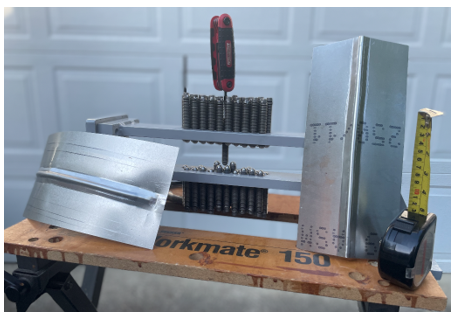New Agile Manufacturing Tools
Outcome/Accomplishment
Hybrid Autonomous Manufacturing–Moving from Evolution to Revolution (HAMMER) is an NSF-funded Engineering Research Center (ERC) headquartered at The Ohio State University (OSU). HAMMER is leveraging metal deformation technology for agile manufacturing in new ways. Several entirely new metal-forming approaches are being developed. One of these, the Bendy-Bot, is intended for use in point-of-care medical manufacturing to assist a surgeon to create dimensionally precise fixation plates for trauma or other needs where bone must be held together with standard titanium fixation plates. These plates are expected to be produced more quickly and accurately than those by the current manual process. A second example is the American Pin Bed. It adapts some of the core ideas in roll-forming to incrementally make long profiled sections by moving pins incrementally by small amounts between each pass and then sliding the sheet back and forth in a programmed way to make components.
Impact/Benefits
These agile tools offer much of the promise of additive manufacturing but use deformation processing to create the structures. Deformation processing may be faster and provide better material properties than additive manufacturing. Deformation processing is also adaptable to a far larger number of materials and possibly lower cost.
Explanation/Background
The Bendy-Bot is currently optimized for common, linear fixation plates. In advancing hole to hole, the normal vector to the sheet is set by deformation to assure curvature and overall conformation to the target geometry. Residual stress can be controlled by varying the order of bending operations. PhD student Brian Thurston developed this concept and it is now the subject of further research for control algorithms to develop precise shapes quickly.
The American Pin Bed extends the rich literature in roll forming, which has demonstrated the ability to create a wide variety of shapes. The innovation is in the fact that only a single stand of pins is used, wherein in roll forming, large roll-stand facilities are used. This approach is now being automated and may see application in the development of structures in low earth orbit or outer space.
Location
Columbus, Ohiowebsite
Start Year
Advanced Manufacturing
Advanced Manufacturing
Lead Institution
Core Partners
Fact Sheet
Outcome/Accomplishment
Hybrid Autonomous Manufacturing–Moving from Evolution to Revolution (HAMMER) is an NSF-funded Engineering Research Center (ERC) headquartered at The Ohio State University (OSU). HAMMER is leveraging metal deformation technology for agile manufacturing in new ways. Several entirely new metal-forming approaches are being developed. One of these, the Bendy-Bot, is intended for use in point-of-care medical manufacturing to assist a surgeon to create dimensionally precise fixation plates for trauma or other needs where bone must be held together with standard titanium fixation plates. These plates are expected to be produced more quickly and accurately than those by the current manual process. A second example is the American Pin Bed. It adapts some of the core ideas in roll-forming to incrementally make long profiled sections by moving pins incrementally by small amounts between each pass and then sliding the sheet back and forth in a programmed way to make components.
Location
Columbus, Ohiowebsite
Start Year
Advanced Manufacturing
Advanced Manufacturing
Lead Institution
Core Partners
Fact Sheet
Impact/benefits
These agile tools offer much of the promise of additive manufacturing but use deformation processing to create the structures. Deformation processing may be faster and provide better material properties than additive manufacturing. Deformation processing is also adaptable to a far larger number of materials and possibly lower cost.
Explanation/Background
The Bendy-Bot is currently optimized for common, linear fixation plates. In advancing hole to hole, the normal vector to the sheet is set by deformation to assure curvature and overall conformation to the target geometry. Residual stress can be controlled by varying the order of bending operations. PhD student Brian Thurston developed this concept and it is now the subject of further research for control algorithms to develop precise shapes quickly.
The American Pin Bed extends the rich literature in roll forming, which has demonstrated the ability to create a wide variety of shapes. The innovation is in the fact that only a single stand of pins is used, wherein in roll forming, large roll-stand facilities are used. This approach is now being automated and may see application in the development of structures in low earth orbit or outer space.


